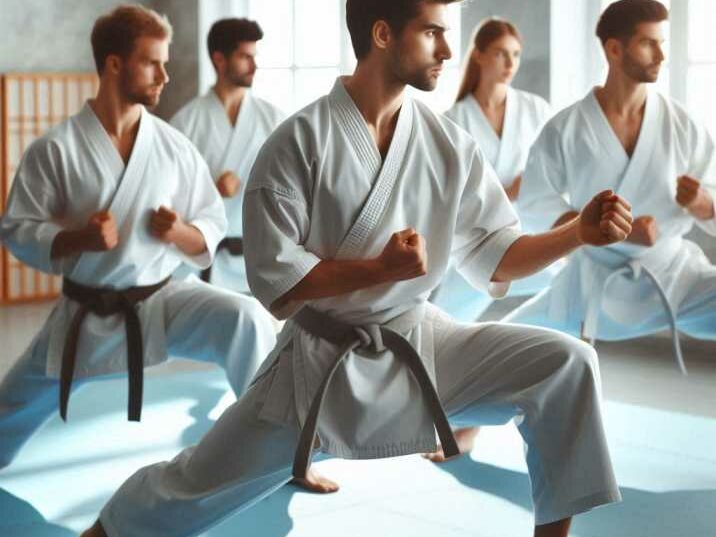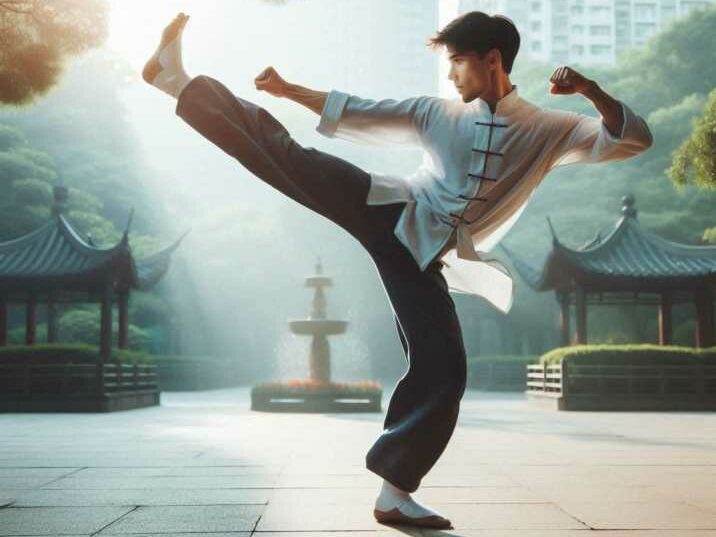Introduction: Discovering the Martial Arts World
Table of Contents
When you think of martial arts, images of powerful kicks, swift punches, and intense training often come to mind. Among the most popular martial arts are Karate and Kung Fu. Many people often wonder, “What is the difference between Karate and Kung Fu?” While they share some similarities, Karate and Kung Fu are distinct in their origins, techniques, and philosophies. In this article, we’ll dive into the fascinating world of these two martial arts, uncovering their unique characteristics and helping you understand what sets them apart.

The Origins of Karate and Kung Fu: A Journey Through History
Tracing the Roots of Karate: From Okinawa to the World
Karate originated in the Ryukyu Kingdom, which is now Okinawa, Japan. This martial art developed from indigenous fighting methods combined with Chinese martial arts brought to Okinawa through trade and cultural exchange. The term “Karate” means “empty hand,” reflecting its focus on unarmed combat. Karate emphasizes linear movements, powerful strikes, and a strong stance, making it a formidable form of self-defense.
The development of modern Karate can be traced back to the early 20th century when it was introduced to mainland Japan. Gichin Funakoshi, a prominent Okinawan martial artist, played a key role in popularizing Karate in Japan and beyond. Today, Karate is practiced worldwide, with numerous styles and schools dedicated to preserving and evolving this ancient art.
The Rich Heritage of Kung Fu: A Chinese Legacy
Kung Fu, on the other hand, has a rich and diverse history rooted in China. The term “Kung Fu” translates to “skill achieved through hard work,” and it encompasses a wide range of martial arts styles and techniques. Kung Fu has been practiced for thousands of years, with influences from Chinese philosophy, religion, and culture. Unlike Karate’s linear movements, Kung Fu is known for its fluid, circular motions, and a wide variety of techniques, including strikes, kicks, throws, and joint locks.
The origins of Kung Fu can be traced back to ancient China, where it was developed as a means of self-defense, hunting, and military training. Over time, various schools and styles emerged, each with its unique techniques and philosophies. Some of the most well-known styles include Shaolin Kung Fu, Wing Chun, and Tai Chi. The Shaolin Monastery, in particular, is renowned for its contributions to the development and preservation of Kung Fu, with its monks becoming legendary martial artists.
Techniques and Training: How Karate and Kung Fu Differ
Karate Techniques: Precision and Power
Karate training focuses on developing strong, precise movements. Practitioners learn various strikes, including punches, kicks, knee strikes, and elbow strikes. Karate also emphasizes blocking and counter-attacking techniques to defend against opponents. Training involves practicing “katas,” which are predefined sequences of movements that simulate combat scenarios. These katas help students develop muscle memory, balance, and coordination.
In addition to katas, Karate training often includes sparring (kumite) and breaking techniques (tameshiwari), where practitioners demonstrate their ability to break boards, bricks, and other materials. This aspect of training not only tests physical strength but also mental focus and discipline.
Strikes and Kicks
Karate’s strikes are characterized by their direct, powerful nature. Practitioners learn to deliver punches with pinpoint accuracy and maximum force, often targeting vital points on an opponent’s body. Kicks in Karate are designed to be swift and effective, with techniques like the front kick (mae geri), side kick (yoko geri), and roundhouse kick (mawashi geri) being staples of the art.
Blocking and Counter-Attacking
Blocking in Karate is just as important as striking. Practitioners learn to use their arms and legs to deflect incoming attacks, creating openings for counter-attacks. Techniques such as the rising block (age uke), downward block (gedan barai), and inside block (uchi uke) are essential components of a Karateka’s defensive arsenal.
Katas
Katas are formal exercises consisting of a series of movements and techniques performed in a specific sequence. Each kata represents a simulated battle against multiple opponents, allowing practitioners to practice their techniques in a controlled, repetitive manner. Katas help develop muscle memory, improve balance and coordination, and instill the principles of timing and rhythm.
Sparring (Kumite) and Breaking (Tameshiwari)
Sparring, or kumite, allows Karate practitioners to apply their techniques in a dynamic, real-world setting. It helps develop timing, distance control, and the ability to read an opponent’s movements. Breaking techniques, or tameshiwari, test a practitioner’s ability to focus their power and demonstrate the effectiveness of their strikes. These techniques often involve breaking boards, bricks, and other materials, showcasing both physical and mental strength.
Kung Fu Techniques: Fluidity and Flexibility
Kung Fu encompasses a wide range of styles, each with its unique techniques and training methods. Common techniques include strikes, kicks, joint locks, throws, and grappling. Kung Fu practitioners often train in forms, which are choreographed routines that combine various techniques into a fluid sequence. These forms help students improve their flexibility, agility, and overall martial arts skills. Some well-known Kung Fu styles include Wing Chun, Shaolin, and Tai Chi, each with its distinct characteristics and training methods.

Strikes and Kicks
Kung Fu strikes are known for their speed, precision, and versatility. Practitioners learn a variety of striking techniques, often involving open hands, claws, and fists. Kicks in Kung Fu are dynamic and can be delivered from various angles and heights. Techniques such as the straight punch, palm strike, and dragon claw strike are commonly practiced, along with kicks like the front kick, side kick, and spinning back kick.
Joint Locks and Throws
Joint locks and throws are integral parts of many Kung Fu styles. Practitioners learn to manipulate an opponent’s joints, using leverage and technique to control and subdue them. Throws involve using an opponent’s momentum against them, executing techniques that unbalance and topple them to the ground.
Forms (Taolu)
Forms, or taolu, are choreographed sequences of movements that combine strikes, kicks, blocks, and other techniques. Each form represents a specific style or school of Kung Fu and serves as a means to practice and internalize the art’s principles. Forms vary in complexity and length, with some focusing on external movements and others emphasizing internal energy cultivation.
Internal Energy (Qi)
Kung Fu training also emphasizes the development of internal energy, or “qi,” through breathing exercises, meditation, and specific movements. This focus on internal energy helps practitioners achieve greater control over their bodies and minds, leading to improved overall health and well-being. Techniques such as Tai Chi incorporate slow, deliberate movements designed to cultivate and balance qi, enhancing both martial prowess and personal vitality.
Philosophy and Mindset: The Essence of Karate and Kung Fu
The Way of Karate: Discipline and Respect
Karate is more than just physical training; it is also a way of life. The philosophy of Karate emphasizes discipline, respect, and continuous self-improvement. Practitioners are taught to respect their instructors, fellow students, and themselves. The principles of Karate encourage humility, perseverance, and a strong moral character. This mindset helps students apply the lessons learned in training to their everyday lives.
Karate training often begins and ends with a bow, a gesture of respect that signifies the importance of humility and discipline. Students are also taught the importance of “bushido,” the samurai code of honor, which emphasizes virtues such as loyalty, courage, and self-control.
The Spirit of Kung Fu: Harmony and Balance
Kung Fu philosophy is deeply rooted in Chinese culture and philosophy. It emphasizes the importance of harmony and balance in all aspects of life. Kung Fu practitioners strive to achieve physical, mental, and spiritual balance through their training. This holistic approach encourages students to develop not only their martial arts skills but also their character and well-being. The practice of Kung Fu often incorporates elements of Chinese medicine, meditation, and philosophy, making it a comprehensive and enriching experience.
The concept of “yin and yang,” which represents the balance of opposing forces, is central to Kung Fu philosophy. Practitioners learn to harmonize these forces within themselves and their surroundings, leading to greater overall balance and harmony in their lives.
Practical Applications: Self-Defense and Beyond
Karate for Self-Defense: Strength and Simplicity
Karate is highly effective for self-defense due to its focus on powerful strikes and straightforward techniques. Practitioners are trained to deliver quick, decisive blows to incapacitate an attacker. The emphasis on blocking and counter-attacking makes Karate a practical choice for real-world self-defense situations. Additionally, the discipline and mental toughness developed through Karate training can help individuals stay calm and focused under pressure.
Karate’s simplicity and directness make it accessible to people of all ages and fitness levels. Its techniques can be adapted to suit individual needs, making it an excellent choice for personal protection.
Kung Fu in Action: Adaptability and Versatility
Kung Fu’s diverse range of techniques and styles makes it adaptable to various self-defense scenarios. Practitioners learn to use their environment and body mechanics to their advantage, making Kung Fu highly versatile. The fluid, circular motions of Kung Fu can be particularly effective in redirecting an opponent’s energy and using it against them. Beyond self-defense, Kung Fu also offers numerous health benefits, including improved flexibility, strength, and cardiovascular fitness.
Kung Fu training often includes weapons training, such as the use of staffs, swords, and nunchaku. This aspect of training not only enhances self-defense skills but also provides a deeper understanding of traditional martial arts techniques.
Table of Information: Comparing Karate and Kung Fu
| Aspect | Karate | Kung Fu |
|---|---|---|
| Origin | Okinawa, Japan | China |
| Meaning | “Empty hand” | “Skill achieved through hard work” |
| Techniques | Strikes, kicks, blocks, katas | Strikes, kicks, throws, joint locks, forms |
| Philosophy | Discipline, respect, self-improvement | Harmony, balance, holistic development |
| Training | Linear movements, powerful strikes | Fluid motions, diverse techniques |
| Self-Defense | Practical, straightforward | Adaptable, versatile |
| Famous Styles | Shotokan, Goju-Ryu, Shito-Ryu | Wing Chun, Shaolin, Tai Chi |
Conclusion: Embracing the Differences and Similarities
In summary, while Karate and Kung Fu share some common ground as martial arts, they are distinct in their origins, techniques, philosophies, and training methods. Karate, with its roots in Okinawa, emphasizes powerful, linear movements and a disciplined mindset. Kung Fu, originating from China, encompasses a wide range of styles and techniques, focusing on fluidity, balance, and harmony. Both martial arts offer unique benefits and can provide a fulfilling and enriching experience for practitioners.
FAQs
1. What are the main differences between Karate and Kung Fu?
Karate focuses on powerful, linear strikes and originates from Okinawa, Japan, while Kung Fu emphasizes fluid, circular motions and comes from China. Each martial art has distinct techniques, philosophies, and training methods.
2. Which is better for self-defense, Karate or Kung Fu?
Both Karate and Kung Fu are effective for self-defense. Karate offers straightforward, powerful techniques, while Kung Fu provides versatile, adaptable methods. The best choice depends on personal preference and specific self-defense needs.
3. Can children learn Karate and Kung Fu?
Yes, children can learn both Karate and Kung Fu. These martial arts help kids develop physical fitness, discipline, and self-confidence. Many schools offer specialized classes for children, making training safe and enjoyable.
4. How long does it take to become proficient in Karate and Kung Fu?
The time required to become proficient varies based on individual dedication, frequency of training, and the specific style being practiced. Generally, it takes several years of consistent practice to achieve a high level of skill in either martial art.
5. Are there competitions for Karate and Kung Fu?
Yes, both Karate and Kung Fu have competitive aspects. Karate competitions often involve kata (form) and kumite (sparring) events. Kung Fu competitions may include forms, sparring, and demonstrations of various techniques. Competitions provide an opportunity for practitioners to showcase their skills and gain valuable experience.


